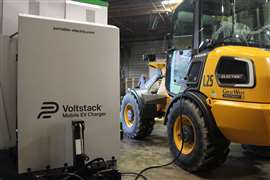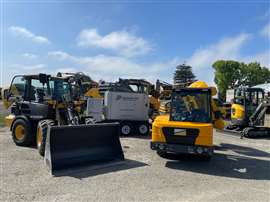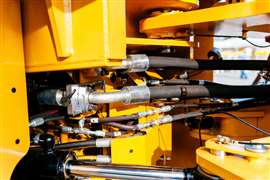Read this article in French German Italian Portuguese Spanish
Interview: taking charge of electric machines
19 August 2024
 Photo: Portable Electric
Photo: Portable Electric
Ensuring that electric machines match up to both the performance and runtime of their diesel-powered counterparts requires significant advances in charging infrastructure.
And, while the runtime anxiety may still be at the forefront of the minds of many users, OEMs have continued to develop systems that take some of that anxiety away.
That’s exactly what Canada-based Portable Electric, a provider of clean energy portable and mobile electric generators or power stations, aims to achieve.
Founded in 2015, initially as a supplier of smaller portable off-grid solutions to the film industry, the company has more recently ventured into larger applications that can provide charging support for construction equipment.
An example of this came in May when the company, alongside Volvo CE, launched the PU130 mobile battery energy storage system (BESS), which enables rapid recharging of electrified construction equipment.
The PU130 has a 130kWh storage capacity and integrates Portable Electric’s proprietary 48V Direct Current Fast Charging (DCFC) technology to allow rapid recharging of electrified equipment at a 20kW charge rate. The unit also simultaneously provides 40kW of jobsite power to support tools, lighting, office trailers and more.
To find out more about the collaboration, IRN spoke Portable Electric CEO Keith Marett. Here is what he had to say.
IRN: Tell us about your background in the industry
I’ve been in the industry for more than a decade, working with companies like Tesla on their energy products before then ultimately selling that business to a company called Generac Power Systems.
Then we set up a new business around clean energy, and so storage technology was one of our big attributes and then later last year I joined Portable Electric as CEO using my renewables background. Given the space that Portable Electric is in it made sense (to join).
IRN: In May you announced a partnership with Volvo CE. How many units are you going to manufacture as part of that? Will there be a certain amount annually?
There’s neen a few dozen built to date that we’re operating. Really we’re going to be into the hundreds if not thousands in the next few years and the capacity that we’ve built at our factory allows for that.
We have expansion plans to expand our factory, and to add another footprint of a factory in the US.
 Portable Electric CEO Keith Marett. (Photo: Portable Electric)
Portable Electric CEO Keith Marett. (Photo: Portable Electric)
IRN: Could we see this partnership move globally? Potentially in Europe?
It’s going to start in North America for now and there’s definitely opportunities as Volvo’s needs expand to look at other markets. Obviously, the UK and the other parts of EU make a lot of sense.
One of our other partner companies, which is similar in the vein of Volvo, is in the process of electrifying their construction fleet. They have a big European presence.
As part of our agreement with them is to have a European based product next year. So, starting next year we will have European products built here but delivered to Europe.
But as you can see logically, it makes sense to ultimately have a factory in Europe at some point in time.
These are large assets and the logistics to move them around is cumbersome and I like the idea of localising as much as we can.
IRN: Where are they manufactured currently?
Currently, they’re manufactured in Vancouver, Canada. That’s our headquarters. We do have a service sort of group down in California, but our headquarters is in Vancouver.
IRN: What is the current capacity ranges for the units?
Our smaller ones we have, which are really just battery powered, they’re more on the AC power side, those ones are the 5kW by 7kWh system. We have a larger trailer one which is our 30kW by 80kWh system and that one includes a level two charger.
And then our latest which we announced with Volvo is going to be a 40kW by 130kWh system. On top of that 40kW is the DC fast charger. So, it’s basically a 20kW fast charger. It’s classified as a 40 plus 20.
IRN: Is it an agnostic system or specific for Volvo?
This particular one is built specifically for Volvo. We’ve got another version of it that would be built for the other company, but in that sense it’s all Portable Electric IP that we will adapt for other partner companies.
As a core product, we have a standard offering. It’s more on the charging application and then what we need to build around that charging application to support it is unique. So Volvo has its own communication protocols and different charging protocols.
We have to adapt our system to work with those protocols. We then might have to adapt whether it makes sense for the right power levels or right capacity levels. All of those things need to be taken into consideration.
IRN: You said that it is aimed at more compact units. What could it realistically power in the future?
Based on the technology that we’ve developed, it’s really going after that compact equipment size. Three tonnes or less is typically what we’re dealing with. With Volvo in particular we’re working on their loader systems, as well as their excavators on the smaller side. In that regard, based on the system that we’ve built, we can typically do between six and charges of their equipment per single charge of our system.
From a time duration, really what we’re looking at on the excavator side is anywhere from half an hour to 45 minutes for a full charge and the loader anywhere from a 45 minutes to less than an hour for a full charge.
What we talk about is a lunch break charge, so the user gets to use the equipment in the morning for the tasks that they’re doing. Typically it runs two to three hours or 4 hours on depending on the work, and then they use our system to then recharge it up over that lunch break.
In the current conditions to charge up a unit without our technology, you’re typically looking at six to eight hours to charge up a piece of equipment, and that’s where the advantage of our technology allows that true lunch break charge.
IRN: Are there any plans to power heavier types of equipment?
Under the current configuration it wouldn’t be set up for that, but our next product that we’re working on is in support of that higher capacity equipment. Really what we found was we wanted to tackle the highest opportunity need in the marketplace, and so if you look at Volvo’s portfolio they’ve really focused in on the compact equipment.
They’ve got close to a dozen pieces of equipment that are electrified, and then their larger stuff is starting to electrify. They have a 23 tonne excavator. They’ve just announced a new loader that’s going to be electrified, but those are still early in its days versus the compact equipment.
And so that’s been our focus, and then the next thing that we will address is that high voltage, higher capacity, higher power equipment.
IRN: In the past we have seen large OEM’s acquire companies like Portable Electric. Is that something you could see?
I wouldn’t say anything is off the cards. I think it’s still early days in terms of their view on the market, our view on the market and where we’re at. Right now we’re focused and building a good solid company that is a great partner to companies like Volvo and our other partner companies that we work with.
We’ll see where it goes, but right now it’s really just focusing on being a great partner.
IRN: With electrification and the energy transition, some would argue that Europe is further along than North America. Would you agree with that?
100%. I’ve seen it in all different industries and specifically Europe is really two to three years ahead of North America in terms of its energy transition and electrification efforts.
I think the US is also at the same time learning a lot from what the EU is doing and then picking parts that makes a lot of sense for what it needs for North America in the sense that it is quite unique in a lot of regards.
The energy transition is a little bit slower, they haven’t put the infrastructure in place to allow for it. And so, for instance, construction sites don’t provision for power until much later into the process of construction.
 Photo: Portable Electric
Photo: Portable Electric
IRN: What is the maximum weight that you think electric could support?
That’s a good question. I mean, that’s probably best for Volvo to answer, but with all new technology coming out, we’ll see where it goes. I have my personal views where something like hydrogen makes more sense just because of the sheer economics of what you’re looking at and then just the general weight that you’re going to add.
I do think as you’re getting to a larger system, if it’s a 23 tonne excavator that’s running a 27kWh, battery pack, that’s getting pretty large even on a fast charging scale. You’re still looking at a few hours of recharge time.
With the sheer productivity of it, it’s going to take a bit of a hit and so I think you’re going to see a lot of challenges on that side. So my personal view is getting over the 150kWh battery pack and a piece of equipment is going to be challenging.
IRN: Anything else to add?
The one area that we also invest in is the software space. That’s where there’s going to be a huge amount of value creation. So it’s not just about putting an asset there that’s got the needs for power.
It’s now a whole new construction site that you have to view like when does that excavator or loader need to be recharged and how often and where is the best placement of the assets?
It’s the whole orchestration of a new construction site in terms of viewing it from the energy it is going to be a big undertaking. That’s where I would say a huge focus for us over the last few years has been. Really providing that intelligence layer for the energy.
IRN: How is that presented to the user?
We’ve got everything ourselves. All of our systems are IT connected, they’ve got cellular columns built into them and GPS comps. So with all of it we can grab 200 plus points of data from our equipment every second.
It’s not just our equipment, because we’re interacting and connecting up to electric vehicles like Volvo. We pull that data into our system and then you’ve got a single view of the construction site and so we present that to to our users through a dashboard that they can have access to elite management tools. There’s a lot of investment going into that area from things like predictive maintenance, runtime, state of charge and making sure that you know where the energy is and what’s left and when to charge.
STAY CONNECTED



Receive the information you need when you need it through our world-leading magazines, newsletters and daily briefings.
CONNECT WITH THE TEAM












